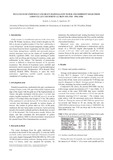Influence of snowmelt and heavy rainfalls on water and sediment yield from loess gully catchment (Lublin upland – Poland)
Fecha
2007Versión
Acceso abierto / Sarbide irekia
Tipo
Contribución a congreso / Biltzarrerako ekarpena
Versión
Versión publicada / Argitaratu den bertsioa
Impacto
|
|
nodoi-noplumx
|
Resumen
The surface discharge from the gully catchments of the
Lublin Upland (Poland) usually is not very high and
amounts to about 15 mm·yr-1. It is mainly an episodic
discharge of snow/rainfall regime. Surface runoff and rill
erosion are caused by rains of the total >10 mm and
intensity >1 mm·min.-1, the main factor of gully erosion is
however snowmelt runoff. Most of the material set in
motion at that ...
[++]
The surface discharge from the gully catchments of the
Lublin Upland (Poland) usually is not very high and
amounts to about 15 mm·yr-1. It is mainly an episodic
discharge of snow/rainfall regime. Surface runoff and rill
erosion are caused by rains of the total >10 mm and
intensity >1 mm·min.-1, the main factor of gully erosion is
however snowmelt runoff. Most of the material set in
motion at that time remains at the bottom of the gully, and
can be carried away during heavy rainfalls. [--]
Materias
Gully erosion,
Snowmelt,
Heavy rainfalls
Editor
Universidad Pública de Navarra / Nafarroako Unibertsitate Publikoa
Publicado en
Javier Casalí, Rafael Giménez (eds.): Progress in Gully Erosion Research. IV International Symposium on Gully Erosion. September 17-19, 2007. Pamplona, Spain. Pamplona: Universidad Pública de Navarra / Nafarroako Unibertsitate Publikoa, 2007
Notas
Resumen del trabajo presentado al IV International Symposium on Gully Erosion, celebrado en la Universidad Pública de Navarra del 17 al 19 de septiembre de 2007.
Entidades Financiadoras
The work reported in this paper was financially
supported by the programmes of Scientific Research Committee (Poland):
“KBN 3P04E 01322” and “PZB-KBN-086/P04/2003”.



